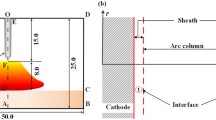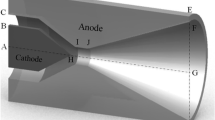Abstract
The effect of calculating thermodynamic and transport properties of a gas mixture with mixing rules on the flow field in the modeling of a thermal plasma jet was studied. A 3D large eddy simulation model of a non-transferred direct current hybrid water/argon plasma torch issuing in nitrogen atmosphere at 400 K was developed to compare three different models for the calculation of transport and thermodynamic properties of the ternary gas mixture. In the first model, thermodynamic and transport properties of the pure gases are used with mixing rules to estimate the mixture properties. In the second model, the properties of plasma gas (Ar/H2O) are calculated rigorously and mixing rules are used for estimating the properties of the mixture of plasma gas and nitrogen. In the third model, the thermodynamic and transport properties of the ternary gas mixture are calculated rigorously without any mixing rules. From numerical results, the error introduced by using mixing rules was evaluated through comparison of calculated temperature, velocity and concentration profiles of the flow field at different positions downstream of the torch exit nozzle. It was found that the differences in transport properties between the exact solutions and the results from calculation with mixing rules can yield significantly different flow fields.
















Similar content being viewed by others
References
Boussagol A, Mariaux G, Legros E, Vardelle A, Nylen P (2001) 3-D modeling of a DC plasma jet using different commercial CFD codes. In: Proceedings of 15th international symposium on plasma chemistry, Orléans, France, GREMI CNRS, pp 1015–1020
Mariaux G, Vardelle A (2005) 3D time-dependent modeling of the plasma spray process, part 1: flow modeling. Int J Therm Sci 44:357–366
Murphy AB (1996) A comparison of treatments of diffusion in thermal plasmas. J Phys D Appl Phys 29:1922–1932
Balmigere G, Meillot E, Vincent S, Caltagirone J-P (2007) Unsteady 3D large eddy simulation of an Ar–H2 plasma jet: analysis of initial results. In: Thermal spray: global coating solutions, pp 185–189
Cheng K, Chen X, Pan W (2006) Comparison of laminar and turbulent thermal plasma jet characteristics—a modeling study. Plasma Chem Plasma Process 26:211–235
Selvan B, Ramachandran K (2009) Comparisons between two different three-dimensional arc plasma torch simulations. J Therm Spray Technol 18(5–6):846–857
Trelles JP, Chazelas C, Vardelle A, Heberlein JVR (2009) Arc Plasma torch modeling. J Therm Spray Technol 18(5–6):728–752
Murphy AB, Arundell CJ (1994) Transport coefficients of argon, nitrogen, oxygen, argon–nitrogen and argon–oxygen plasmas. Plasma Chem Plasma Process 14:451–490
Gleizes A, Cressault Y, Teulet Ph (2010) Mixing rules for thermal plasma properties in mixtures of argon, air and metallic vapours. Plasma Sources Sci Technol 19:1–13
Coufal O, Sezemsky P, Živný O (2005) Database system of thermodynamic properties of individual substances at high temperatures. J Phys D Appl Phys 38:1265–1274
Coufal O (2007) Composition and thermodynamic properties of thermal plasma up to 50kK. J Phys D Appl Phys 40:3371–3385
Krenek P (2008) Thermophysical properties of H2O–Ar plasmas at Temperatures 400–50,000 K and pressure 0.1 MPa. Plasma Chem Plasma Process 28:107–122
Li H-P, Chen X (2001) Three-dimensional modeling of a DC non-transferred arc plasma torch. J Phys D Appl Phys 34:L99–L102
Li H-P, Pfender E (2007) Three dimensional modeling of the plasma spray process. J Therm Spray Technol 16(2):245–260
Huang R, Fukanuma H, Uesugi Y, Tanaka Y (2011) An improved local thermal equilibrium model of DC arc plasma torch. IEEE Trans Plasma Sci 39(10):1974–1982
Dilawari AH, Szekely J, Westhoff R, Detering BA, Shaw CB Jr., (1991) A comparison of the experimentally measured and theoretically predicted temperature profiles for an argon jet discharging into a nitrogen environment. Mater Res Soc Proc 190:199–205
Westhoff R, Szekely J (1991) A model of fluid, heat flow, and electromagnetic phenomena in a nontransferred arc plasma torch. J Appl Phys 70(7):3455–3466
Guenadou D, Meillot E, Saget A (2005) Particle treatment modeling in a time-dependent DC plasma flow. In: Thermal spray connects: explore its surfacing potential! pp 326–331
Eichert P, Imbert M, Coddet C (1998) Numerical study of an Ar–H2 gas mixture flowing inside and outside a DC plasma torch. J Therm Spray Technol 7(4):505–512
Meillot E, Vincent S, Caruyer C, Caltagirone J-P, Damiani D (2009) From DC time-dependent thermal plasma generation to suspension plasma-spraying interactions. J Therm Spray Technol 18(5–6):875–886
Meillot E, Guenadou D, Bourgois C (2008) Three-dimension and transient DC plasma flow modeling. Plasma Chem Plasma Process 28:69–84
Baudry C, Mariaux G, Vardelle A, Delalondre C, Meillot E (2003) Modeling of arc formation in a DC plasma spray torch. In: Proceedings of ISPC-16, Taormina, Italy, Wiley
Vincent S, Balmigere G, Caruyer C, Meillot E, Caltagirone J-P (2009) Contribution to the modeling of the interaction between a plasma flow and a liquid jet. Surf Coat Technol 203:2162–2171
Gleizes A, Gonzalez JJ, Freton P (2005) Thermal plasma modelling. J Phys D Appl Phys 38:R153–R183
Trelles JP, Pfender E, Heberlein J (2006) Multiscale finite element modeling of arc dynamics in a DC plasma torch. Plasma Chem Plasma Process 26:557–575
Colombo V, Ghedini E, Sanibondi P (2010) A three-dimensional investigation of the effects of excitation frequency and sheath gas mixing in an atmospheric-pressure inductively coupled plasma system. J Phys D Appl Phys 43(1):13
Wilke CR (1950) A viscosity equation for a gas mixture. J Chem Phys 18(4):517–519
Mason EA, Saxena SC (1958) Approximate formula for the thermal conductivity of gas mixture. Phys Fluids 1(5):361–369
Murphy AB (2012) Transport coefficients of plasmas in mixtures of nitrogen and hydrogen. Chem Phys 398:64–72
Palmer GE, Wright MJ (2003) Comparison of methods to compute high-temperature gas viscosity. J Thermophys Heat Transf 17(2):232–239
Hrabovský M, Kopecký V, Sember V, Kavka T, Chumak O, Konrád M (2006) Properties of hybrid water/gas DC arc plasma torch. IEEE Trans Plasma Sci 34(4):1566–1575
Williamson RL, Fincke JR, Crawford DM, Snyder SC, Swank WD, Haggard DC (2003) Entrainment in high-velocity, high-temperature plasma jets. Part II: computational results and comparison to experiment. Int J Heat Mass Transf 46:4215–4228
Lorcet H, Brothier M, Guenadou D, Latge C, Vardelle A (2010) Modeling bio-oil gasification by a plasma process. High Temp Mater Process 14:11–27
Hrabovský M, Konrád M, Kopecký V, Sember V (2003) In: Solonenko OP (ed) Thermal plasma torches and technologies, 1st edn. Cambridge International Science Publishing, Cambridge
Murphy AB, Tam E (2014) Thermodynamic properties and transport coefficients of arc lamp plasmas: argon, krypton and xenon. J Phys D Appl Phys 47: 295202 (10p)
Murphy AB (2000) Transport coefficients of hydrogen and argon–hydrogen plasmas. Plasma Chem Plasma Process 20:279–297
Murphy AB (1995) Transport coefficients of air, argon–air, nitrogen–air, and oxygen–air plasmas. Plasma Chem Plasma Process 15:279–307
Boulos M, Fauchais P, Pfender E (1995) Thermal plasmas: fundamental and applications. Plenum Press, New York
Murphy AB (1993) Diffusion in equilibrium mixtures of ionized gases. Phys Rev E 48:3594–3603
Aubrecht V, Bartlova M, Urban F, Valenta J (2004) Partial characteristics of radiation for thermal plasmas in H2O and argon. In: Proceedings of 15th international conference on gas discharges and their applications, Toulouse, France, pp 141–144
Acknowledgments
The author gratefully acknowledges the support of this work by the Agency for Innovation by Science and Technology in Flanders (IWT).
Author information
Authors and Affiliations
Corresponding author
Appendix 1: Expression for the Diffusion Flux in a Three-Component Mixture in Terms of Binary Combined Diffusion Coefficients
Appendix 1: Expression for the Diffusion Flux in a Three-Component Mixture in Terms of Binary Combined Diffusion Coefficients
A gas mixture of Ar (A), H2O (B) and N2 (C) is considered. The diffusion flux of gas A (consisting of species 1 to p) can be written as:
in which i = 1,…,q corresponds to the species making up gas B and C. x (3) j represents the mole fraction of species j in the three-component gas mixture. For further details on the derivation of this expression, see Murphy [38].
Because the mole fraction of species j (x (3) j ) is function of temperature and composition, and because composition is determined by the mole fractions of two out of three gases, the gradient of the mole fraction becomes:
in which x B and x C are respectively the mole fractions of gas B and gas C at temperature T. The species 1 to q are the collection of species originating from both gas B and gas C. Since no combination species are considered between species from B and species from C, the species 1,…,q can be split up into 1,…,q B (species from gas B) and q B + 1,…,q C (species from gas C). The following relations are then being considered:
For j = 1,…,q B :
with x (2) j the mole fraction of species j in the binary gas mixture of A and B with the same mole fraction of gas B, x B as in the three-component gas mixture.For j = q B + 1,…,q C :
with x (2) j the mole fraction of species j in the binary gas mixture of A and C with the same mole fraction of gas C, x C as in the three-component gas mixture.
With the definitions of combined diffusion coefficients:
with D T(AB) i the thermal diffusion coefficient of species i in the binary mixture of A and B
with D T(AC) i the thermal diffusion coefficient of species i in the binary mixture of A and C
The diffusion flux of gas A becomes:
with the extra term S:
in which D T(3) i is the thermal diffusion coefficient of species i in the three-component mixture. The term S consists of the terms describing the Soret effect, which is considered small, therefore the term S is neglected in the expression for the diffusion flux of gas A in the three-component mixture of A, B and C.
Rights and permissions
About this article
Cite this article
Agon, N., Vierendeels, J., Hrabovský, M. et al. Interaction of a H2O/Ar Plasma Jet with Nitrogen Atmosphere: Effect of the Method for Calculating Thermophysical Properties of the Gas Mixture on the Flow Field. Plasma Chem Plasma Process 35, 365–386 (2015). https://doi.org/10.1007/s11090-014-9605-6
Received:
Accepted:
Published:
Issue Date:
DOI: https://doi.org/10.1007/s11090-014-9605-6




